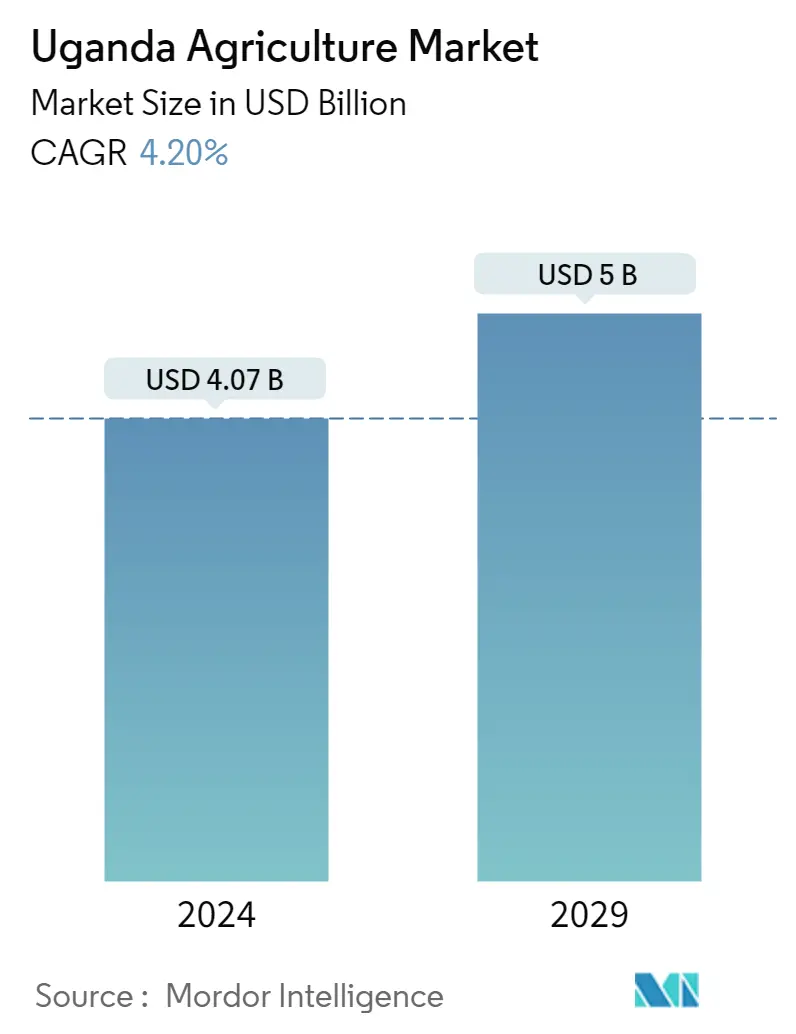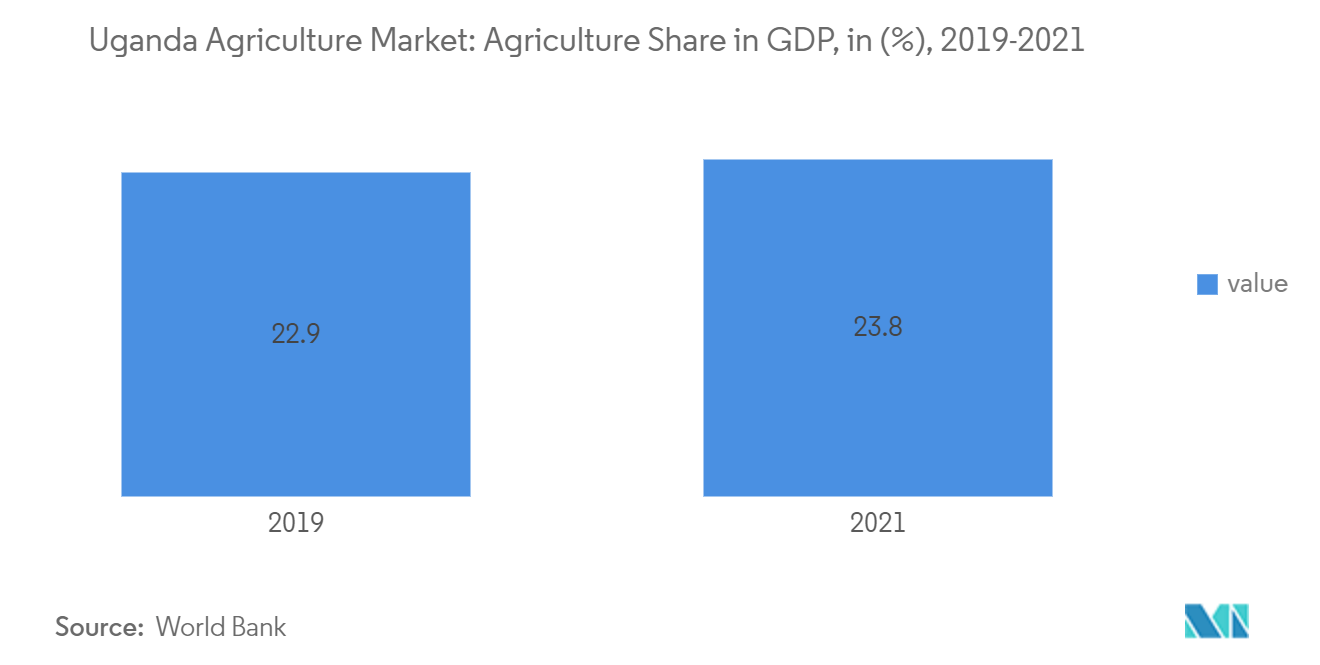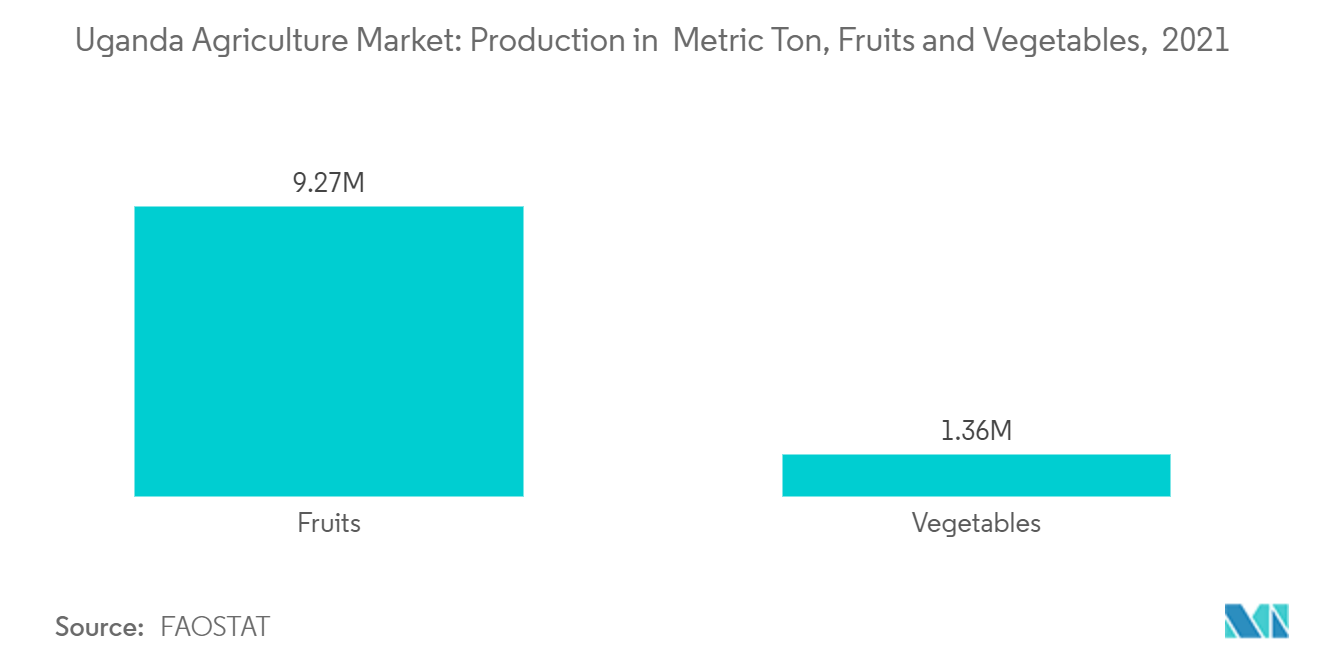
| Study Period | 2019 - 2029 |
| Base Year For Estimation | 2023 |
| Forecast Data Period | 2024 - 2029 |
| Historical Data Period | 2019 - 2022 |
| Market Size (2024) | USD 4.07 Billion |
| Market Size (2029) | USD 5.00 Billion |
| CAGR (2024 - 2029) | 4.20 % |
Uganda Agriculture Market Analysis
The Uganda Agriculture Market size is estimated at USD 4.07 billion in 2024, and is expected to reach USD 5 billion by 2029, growing at a CAGR of 4.20% during the forecast period (2024-2029).
- Agriculture has always been of great importance to Uganda. It is the primary sector of the Ugandan economy and the main employer. Over the coming years, the agriculture sector is expected to be the key contributing factor in the country's efforts to decrease poverty and attain economic growth. Uganda has one of the fastest population growth rates. As per the UN World Population Prospects statistics, the population of Uganda in 2022 was 47,249,585, a 3.04% increase from 2021, which is the principal driver for the growth in the consumption of crops in Uganda. However, limited production owing to major productivity restraints, due to the unavailability of good quality seeds and proper irrigation, as well as lack of linkages between formal and informal seed sectors, contribute the most toward restraining the development of the agriculture sector in Uganda.
- For decades the Ugandan federal government has been highly supportive of agriculture. It has been supporting the agriculture industry with a number of policies, trying to stabilize the output and seeking out ways to make sure the sector is growing healthily and sustainably. There is broad political consensus as to the need for labor, land, and tax reform to help the sector reach its potential. Due to supportive policies, the agriculture sector's performance has been improving steadily in recent years in Uganda.
Uganda Agriculture Market Trends
Agriculture Contributes Highly to Uganda’s GDP
- For several years, agriculture has been the backbone of Uganda. The country has a warm climate, ample fertile land, and periodical rainfall. According to the UN FAO, Uganda's fertile agricultural land has the potential to feed 200 million people. Eighty percent of Uganda's land is arable, but only 35% is cultivated. In 2021-22, agriculture accounted for approximately 23% of GDP and 33% of export earnings. The UBOS (Uganda Bureau of Statistics) estimates that about 70% of Uganda's working population is employed in agriculture.
- The agricultural sector has benefited from government efforts toward strengthening the country's competitive advantage in the agricultural production sector. For instance, in June 2022, the Ugandan government contributed nearly USD 10 million to the latest phase of a South-South Cooperation project focused on crop and animal production with the FAO and the Chinese government after the first two phases yielded dramatic results, including a quadrupling of rice production per hectare.
- An increase in the adoption of good agricultural practices and investments in agriculture by private players are expected to boost the growth of agriculture in Uganda during the forecast period. Based on data from the Uganda Bureau of Statistics in 2022, crop production was the most widespread agricultural activity, with 99% of agricultural households engaged in it. Crops are produced predominantly for their own consumption, with 14% of agricultural households cultivating exclusively for their own consumption and an additional 68% cultivating mainly for own consumption, although with some sales.

Fruits and Vegetables Dominate the Ugandan Agriculture Market
- In Uganda, consumers are discovering the link between healthy food and their well-being and switching to fruits and vegetables. In addition, with the rising health consciousness, there is an increasing consumption trend of varieties of off-season fruits, which are being met by rising imports. Even a larger number of smallholders are likely to be involved in the production of fruits and vegetables for the domestic and regional markets.
- Uganda produces and processes large quantities and varieties of fruits, including pineapples, mangoes, passion fruit, and tomatoes. There is also much room to improve the use of machinery and advanced technologies in the agriculture sector. The country has made efforts to integrate new agricultural technologies to improve the sector's efficiency and increase land productivity.
- Apples, citrus, grapes, bananas, litchis, peaches, pineapples, potatoes, tomatoes, onions, sweet corn, beetroots, and avocados are some of the major fruits and vegetable crops identified that are expected to show high growth potential in the regional market during the coming years. The growing awareness of healthy diets and environmental issues is predicted to boost the demand for organic fruits and vegetables. Uganda's climate and landscape are ideal for meeting this demand for organic fruits and vegetables. It has a bimodal rainfall pattern, several water bodies and rivers, and large agricultural land.

Uganda Agriculture Industry Overview
Uganda Agriculture Market News
- November 2022: The Government of Uganda, through the Ministry of Agriculture, Animal Industries, and Fisheries (MAAIF), together with development partners, launched and released biological control agents for the Mango mealybug (Rastococcus invaders).
- August 2022: The government of Uganda has developed an ambitious yet detailed plan to increase its current production of 402,000 tons of coffee to 1.2 million tons annually by 2025. This will lead to the increased production and productivity of coffee in the country.
- November 2021: An association of farmers known as Hortifresh was formed in the country. The mission of this farmer's cooperative is to create a conducive environment for the long-term cultivation of Uganda's fresh fruits and vegetables. Ugandan farmers of fresh fruits and vegetables are expected to benefit greatly from the association's inception.
Uganda Agriculture Industry Segmentation
The study identifies the agriculture scenario of Uganda and estimates the growth of the crop production and agricultural sector in the country as a whole.
The Ugandan agriculture market includes production analysis (volume), consumption analysis (value and volume), export analysis (value and volume), import analysis (value and volume), and price trend analysis. The market is segmented by type into cereals and grains, oilseeds and pulses, and fruits and vegetables. The report offers market sizing and forecasts in value (USD thousand) and volume (metric tons).
| Type (Production Analysis, Consumption Analysis by Value and Volume, Import Analysis by Value and Volume, Export Analysis by Value and Volume, and Price Trend Analysis) | Cereals and Grains |
| Oilseeds and Pulses | |
| Fruits and Vegetables |
Uganda Agriculture Market Research FAQs
How big is the Uganda Agriculture Market?
The Uganda Agriculture Market size is expected to reach USD 4.07 billion in 2024 and grow at a CAGR of 4.20% to reach USD 5.00 billion by 2029.
What is the current Uganda Agriculture Market size?
In 2024, the Uganda Agriculture Market size is expected to reach USD 4.07 billion.
What years does this Uganda Agriculture Market cover, and what was the market size in 2023?
In 2023, the Uganda Agriculture Market size was estimated at USD 3.91 billion. The report covers the Uganda Agriculture Market historical market size for years: 2019, 2020, 2021, 2022 and 2023. The report also forecasts the Uganda Agriculture Market size for years: 2024, 2025, 2026, 2027, 2028 and 2029.
What are the challenges and opportunities for adopting sustainable agricultural practices in Uganda?
The challenges and opportunities for adopting sustainable agricultural practices in Uganda are a) Soil degradation b) Water conservation
Our Best Selling Reports
Uganda Agriculture Industry Report
The Uganda agriculture market, a cornerstone of the nation's economy, is demonstrating consistent growth, fueled by population increases and robust government support. This sector, pivotal in providing substantial employment and contributing significantly to GDP, is undergoing enhancements through strategic policy support and technological advancements. The market's diversity is underscored by extensive crop production, mainly for local consumption, with a portion geared towards sales, highlighting the important role of Uganda agriculture products. Additionally, fruits and vegetables are becoming increasingly significant within the Uganda agriculture sector as health awareness rises and demand for these products grows.
Efforts to meet the demand for off-season fruits through imports and local production are evident, with smallholders crucially supporting both domestic and regional markets. The potential for expansion in the organic fruits and vegetables segment is considerable, propelled by favorable climatic conditions and shifting consumer preferences towards healthy eating and sustainability. Market segmentation is geared towards not only enhancing the production of fruits and vegetables but also cereals, grains, and oilseeds and pulses. This comprehensive development aims to elevate overall agricultural productivity and market presence in Uganda, revealing a strategic approach detailed in industry reports which predict continued market expansion.
Industry statistics indicate a positive growth rate in the market size, with detailed market reports available for further insights. The report pdf provides a thorough market research analysis, highlighting the growth rate and the structure of the industry. Research companies have noted an impressive industry growth, as documented in the annual report. This industry overview provides crucial industry information and analysis, emphasizing the importance of the market report. The market's structure is well-documented, with industry statistics and growth rate projections offering a clear industry outlook.
Market research companies provide comprehensive reports, including industry analysis and growth forecasts. The industry size and market value are detailed, offering insights into the industry's worth and market share. The market forecast predicts sustained growth, supported by price trend analysis. The market segmentation highlights the diverse market segments, with a focus on cereals, grains, oilseeds, pulses, fruits, and vegetables. Industry trends and market trends are analyzed, providing a clear market outlook and review. The market overview and market predictions offer a detailed analysis, with the report pdf serving as a valuable resource for understanding the market dynamics.




